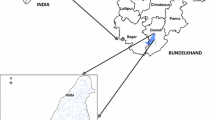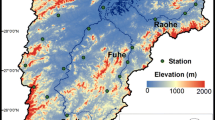Abstract
Identifying hydrological drought in reservoirs is a significant challenge in water resource management. In South Korea, drought in reservoirs has historically been identified and managed through measuring storage amount. However, drought identification in accordance with storage amount has a possibility of failure to secure enough time for proper drought countermeasures. This study aims to suggest supplementary criteria for quantitatively identifying drought based on storage amount and water balance—specifically to allow more time to implement countermeasures against drought on the Andong dam. The standardized balanced index (SBI) was newly suggested to consider dry/wet conditions of dam, and the Standardized storage volume index (SSVI) was employed to consider storage amount. The proper duration of each index was estimated to be 4-month for SBI and 9-month for SSVI. A bivariate drought identification diagram using both index and copula function was derived and applied to the Andong dam. The diagram identified drought to occur 3.7 months earlier than the existing criteria which used storage amount to identify drought, and showed applicability for supplementary criteria.








Similar content being viewed by others
References
Alley WM (1984) The Palmer drought severity index: limitations and assumptions. J Clim Appl Meteorol 23(7):1100–1109
Beguería S, Vicente-Serrano SM, Reig F, Latorre B (2013) Standardized precipitation evapotranspiration index (SPEI) revisited: parameter fitting, evapotranspiration models, tools, datasets and drought monitoring. Int J Climatol 34(10):3001–3023
Chang FJ, Chen L, Chang LC (2005) Optimizing the reservoir operating rule curves by genetic algorithms. Hydrol Process 19(11):2277–2289
Chen L, Singh VP, Guo S, Mishra AK, Guo J (2012) Drought analysis using copulas. J Hydrol Eng 18(7):797–808
Cho J, Jung IW, Kim CG, Kim TG (2016) One-month lead dam inflow forecast using climate indices based on tele-connection. J Korea Water Resour Assoc. https://doi.org/10.3741/JKWRA.2016.49.5.361
Chou FNF, Wu CW, Lin CH (2006) Simulating multi-reservoir operation rules by network flow model. In: Operating reservoirs in changing conditions, 1st edn. ASCE, Virginia, pp. 335–344
Davidson J, Savic D, Walters G (2003) Symbolic and numerical regression: experiments and applications. Inf Sci 150(1–2):95–117
Dong X, Dohmen-Janssen CM, Booij M, Hulscher S (2006) Effect of flow forecasting quality on benefits of reservoir operation—a case study for the Geheyan reservoir (China). Hydrol Earth Syst Sci Dis 3:3771–3814
El-Shafie A, Taha MR, Noureldin A (2007) A neuro-fuzzy model for inflow forecasting of the Nile River at Aswan high dam. Water Resour Manag 21(3):533–556
El-Shafie A, Mukhlisin M, Najah AA, Taha MR (2011) Performance of artificial neural network and regression techniques for rainfall-runoff prediction. Int J Phys Sci 6(8):1997–2003
Eslamian S, Eslamian FA (eds) (2017) Handbook of drought and water scarcity: environmental impacts and analysis of drought and water scarcity. CRC Press, Boca Raton
Galeati G (1990) A comparison of para- metric and non-parametric methods for runoff forecastingA comparison of para- metric and non-parametric methods for runoff forecasting. Hydrol Sci J 35:79–94
Gusyev MA, Hasegawa A, Magome J, Umino H, Sawano H (2015) Drought assessment in the Pampanga River basin, the Philippines. III: evaluating climate change impacts on dam infrastructure with standardized indices. In: Proceedings of the 21st international conference on modelling and simulation (MODSIM 2015), Modelling and Simulation Society of Australia and New Zealand, Inc., Canberra
Guttman NB (1999) Accepting the standardized precipitation index: a calculation algorithm. J Am Water Resour Assoc 35(2):311–322
Hao Z, AghaKouchak A, Nakhjiri N, Farahmand A (2014) Global integrated drought monitoring and prediction system. Sci Data 1(1):1–10
Hao Z, Singh VP (2015) Drought characterization from a multivariate perspective: a review. J Hydrol 527:668–678
Hsu KL, Gupta HV, Sorooshian S (1995) Artificial neural network modeling of the rainfall-runoff process. Water Resour Res 31(10):2517–2530
Huang WC, Chou CC (2008) Risk-based drought early warning system in reservoir operation. Adv Water Resour 31(4):649–660
Jang TI, Park SW, Kim SM (2006) A methodology for the optimal dredge amount estimation to maintain the water supply capacity. In: ASAE annual meeting (1). American Society of Agricultural and Biological Engineers
Jeong DM, Bae DH (2004) Monthly dam inflow forecasts by using weather forecasting information. J Korea Water Resour Assoc. https://doi.org/10.3741/JKWRA.2004.37.6.449
Jung YH (2018) Dam inflow evaluation using hydrograph analysis. J Korean Soc Agric Eng. https://doi.org/10.5389/KSAE.2018.60.3.095
Kallis G (2008) Droughts. Annu Rev Environ Resour 33(1):85–118
Kawade V, Kote H, Gangaji V, Kote AS (2019) Univariate time series prediction of reservoir inflow using artificial neural network. Training 80:75
Kelman J, Stedinger JR, Cooper LA, Hsu E, Yuan SQ (1990) Sampling stochastic dynamic programming applied to reservoir operation. Water Resour Res 26:447–445
Khorshidi MS, Nikoo MR, Sadegh M, Nematollahi B (2019) A multi-objective risk-based game theoretic approach to reservoir operation policy in potential future drought condition. Water Resour Manag 33(6):1999–2014
Kim HS, Kim HS, Jeon GI, Gang SU (2016) Evaluation of the drought from 2014 to 2015 of Korea. Water Future 49(7):61–75. https://www.koreascience.or.kr/article/JAKO201628142625896.page
Kim Y-O, Palmer RN (1997) Value of seasonal flow forecasts in Bayesian stochastic programming. J Water Resour Plan Manag 123(6):327–335
Kim GS, Yim TK, Park CH (2009) Analysis of the secular trend of the annual and monthly precipitation amount of South Korea. Journal of the Korean Society of Hazard Mitig 9(6):17–30. https://www.koreascience.or.kr/article/JAKO200911764897686.do
Kwak J, Kim D, Kim S, Singh VP, Kim H (2014) Hydrological drought analysis in Namhan river basin, Korea. J Hydrol Eng 19(8):05014001
K-Water (2019) Working Reference on Dam Operations, Daejeon, Korea (in Korean)
K-Water (2020) Specification of the Andong Dam, K-Water.http://water.or.kr/realtime/sub01/sub01/dam/hydr.do?s_mid=1323&seq=1408&p_group_seq=1407&menu_mode=3&kwipHydrDamcd=2001110#tab-contentArea (in Korean)
Labadie JW, Bode DA, Pineda AM (1986) Network model for decision support in municipal raw water supply. J Am Water Resour Assoc 22(6):927–940
Lall U, Bosworth K (1994) Multivariate kernel estimation of functions of space and time hydrologic data. In: Stochastic and statistical methods in hydrology and environmental engineering, 1st edn, Springer, Dordrecht, pp 301–315
Lange NT (1999) New mathematical approaches in hydrological modeling—an application of artificial neural networks. Phys Chem Earth Part B 24(1–2):31–35
Liu S, Yan D, Wang H, Li C, Weng B, Qin T (2016) Standardized water budget index and validation in drought estimation of Haihe River Basin, North China. In: Advances in meteorology. https://doi.org/10.1155/2016/9159532
Lee JH, Jung JS, Han UW, Hwang BK (2010) River engineering. Goomi Library Corp, Seoul
Massey FJ Jr (1951) The Kolmogorov–Smirnov test for goodness of fit. J Am Stat Assoc 46(253):68–78
McKee TB, Doesken NJ, Kleist J (1985) Drought monitoring with multiple time scales. In: Proceedings of the 9th conference on applied climatology, Dallas, Texas, pp 233–236
Ministry of the Environment (2019) Adjustment regulation for water supplies in dams. Ministry of the Environment, Korea
Mirabbasi R, Fakheri-Fard A, Dinpashoh Y (2012) Bivariate drought frequency analysis using the copula method. Theor Appl Climatol 108(1–2):191–206
Mishra AK, Singh VP (2010) A review of drought concepts. J Hydrol 391(1–2):202–216
Moeeni H, Bonakdari H, Ebtehaj I (2017) Monthly reservoir inflow forecasting using a new hybrid SARIMA genetic programming approach. J Earth Syst Sci 126(2):18
Mohammadi K, Eslami HR, Dardashti SD (2005) Comparison of regression, Arima and ANN models for reservoir inflow forecasting using snowmelt equivalent (a case study of Karaj). J Agric Sci Technol 7:17–30
Momiyama S, Sagehashi M, Akiba M (2018) Assessment of the climate change risks for inflow into Sagami Dam reservoir using a hydrological model. J Water Clim Change 11:367–379
Nam WH, Choi JY, Jang MW, Hong EM (2013) Agricultural drought risk assessment using reservoir drought index. J Korean Soc Agric Eng. https://doi.org/10.5389/KSAE.2013.55.3.041
National Environment Information Network System (NEINS) Center (2020) The effect of climate change in South Korea. http://www.neins.go.kr/etr/climatechange/doc04b.asp. Accessed 2 Aug 2020 (in Korean)
Nelsen RB (2007) An introduction to copulas. Springer, Berlin
Nohara D, Hori T, Sato Y (2018) Real-time reservoir operation for drought management considering operational ensemble predictions of precipitation in Japan. In: Advances in Hydroinformatics. Springer, Singapore, pp 331–345
Rodriguez JC (2007) Measuring financial contagion: a copula approach. J Empir Finance 14(3):401–423
Saad C, El Adlouni S, St-Hilaire A, Gachon P (2015) A nested multivariate copula approach to hydrometeorological simulations of spring floods: The case of the Richelieu River (Québec, Canada) record flood. Stoch Env Res Risk Assess 29(1):275–294
Serinaldi F, Bonaccorso B, Cancelliere A, Grimaldi S (2009) Probabilistic characterization of drought properties through copulas. Phys Chem Earth Parts A/B/C 34(10–12):596–605
Shafer BA (1982) Development of a surface water supply index (SWSI) to assess the severity of drought conditions in snowpack runoff areas. In: Proceedings of the 50th annual western snow conference. Fort Collins, Colorado State University
Sheffield J, Goteti G, Wen F, Wood EF (2004) A simulated soil moisture based drought analysis for the United States. J Geophys Res 109:D24
Shiau JT (2006) Fitting drought duration and severity with two-dimensional copulas. Water Resour Manage 20(5):795–815
Shiau JT, Modarres R (2009) Copula-based drought severity‐duration‐frequency analysis in Iran. Meteorol Appl J Forecast Pract Appl Train Tech Model 16(4):481–489
Stedinger JR, Sule BF, Loucks DP (1984) Stochastic dynamic programming models for reservoir operation optimization. Water Resour Res 20(11):1499–1505
Thomas HE (1962) The meteorological phenomenon of drought in the Southwest. US Government Printing Office
Tiwari D, Tiwari HL, Saini R (2018) Hydrological modelling in Narmada basin using remote sensing and GIS with SWAT model and runoff prediction in Patan watershed. Int J Adv Res Ideas Innovations Technol 4(2):344–352
Turgeon A (2005) Solving a stochastic reservoir management problem with multi lag autocorrelated inflows. Water Resour Res 41:W12414. https://doi.org/10.1029/2004WR003846
Shukla S, Wood AW (2008) Use of a standardized runoff index for characterizing hydrologic drought. Geophys Res Lett 35(2)
Walker WR, Hrezo MS, Haley CJ (1991) Management of water resources for drought conditions. US Geological Survey Water-Supply Paper 2375, pp 1988–1989
Wang Y, Guo S, Chen H, Zhou Y (2014) Comparative study of monthly inflow prediction methods for the three Gorges Reservoir. Stoch Env Res Risk Assess 28:555–570
Wilhite DA, Glantz MH (1985) Understanding the drought phenomenon: the role of definitions. Water Int 10(3):111–120
Wilhite DA (2000) Drought as a natural hazard: concepts and definitions. In: Drought. A global assessment. Routledge, New York
Svoboda M, Hayes M, Wood D (2012) Standardized precipitation index user guide. World Meteorological Organization, Geneva
Wong G, Van Lanen HAJ, Torfs PJJF (2013) Probabilistic analysis of hydrological drought characteristics using meteorological drought. Hydrol Sci J 58(2):253–270
Wu J, Chen X, Yao H, Gao L, Chen Y, Liu M (2017) Non-linear relationship of hydrological drought responding to meteorological drought and impact of a large reservoir. J Hydrol 551:495–507
Wurbs RA (2005) Modeling river/reservoir system management, water allocation, and supply reliability. J Hydrol 300(1–4):100–113
Xu ZX, Ito K, Liao S, Wang L (1997) Incorporating inflow uncertainty into risk assessment for reservoir operation. Stochast Hydrol Hydraul 11(5):433–448
Yevjevich VM (1967) Objective approach to definitions and investigations of continental hydrologic droughts. An. Hydrology papers (Colorado State University); no. 23
Zhao G, Gao H (2019) Towards global hydrological drought monitoring using remotely sensed reservoir surface area. Geophys Res Lett 46(22):13027–13035
Zhong Y, Guo S, Liu Z, Wang Y, Yin J (2018) Quantifying differences between reservoir inflows and dam site floods using frequency and risk analysis methods. Stoch Env Res Risk Assess 32(2):419–433
Acknowledgements
This work was supported by the National Research Foundation of Korea(NRF) grant funded by the Korea government (MSIT) (No. 2017R1A2B3005695).
Funding
This study was conducted with financial support from the National Research Foundation of Korea (NRF) grant funded by the Korea government (MSIT) (No. 2017R1A2B3005695).
Author information
Authors and Affiliations
Corresponding author
Ethics declarations
Conflict of interest
The authors declare that there are no conflict of interests regarding the publication of this paper.
Additional information
Publisher's Note
Springer Nature remains neutral with regard to jurisdictional claims in published maps and institutional affiliations.
Rights and permissions
About this article
Cite this article
Kwak, J., Joo, H., Jung, J. et al. A case study: bivariate drought identification on the Andong dam, South Korea. Stoch Environ Res Risk Assess 35, 549–560 (2021). https://doi.org/10.1007/s00477-020-01917-7
Accepted:
Published:
Issue Date:
DOI: https://doi.org/10.1007/s00477-020-01917-7




